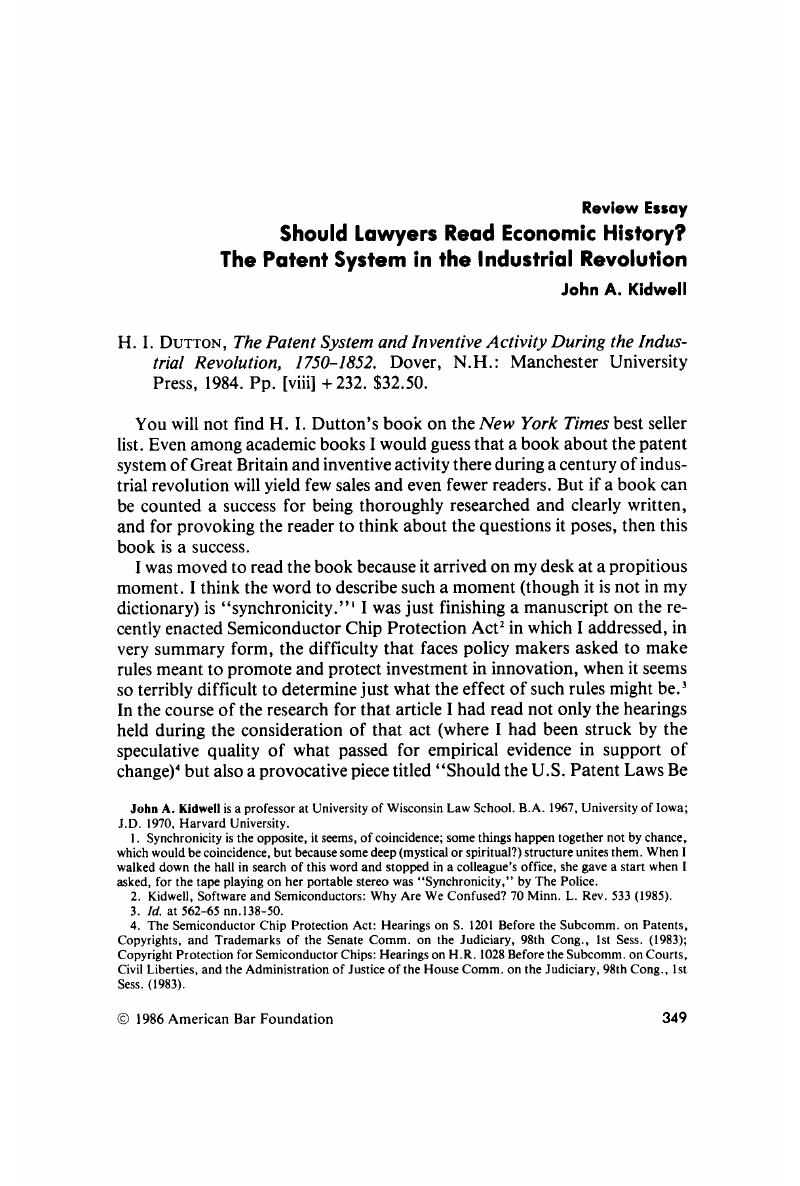No CrossRef data available.
Article contents
Should Lawyers Read Economic History? The Patent System in the Industrial Revolution
Published online by Cambridge University Press: 20 November 2018
Abstract

- Type
- Review Essay
- Information
- Copyright
- Copyright © American Bar Foundation, 1986
References
1 Synchronicity is the opposite, it seems, of coincidence; some things happen together not by chance, which would be coincidence, but because some deep (mystical or spiritual?) structure unites them. When I walked down the hall in search of this word and stopped in a colleague's office, she gave a start when I asked, for the tape playing on her portable stereo was “Synchronicity,” by The Police.Google Scholar
2 Kidwell, Software and Semiconductors: Why Are We Confused? 70 Minn. L. Rev. 533 (1985).Google Scholar
3 Id. at 562–65 nn. 138–50.Google Scholar
4 The Semiconductor Chip Protection Act: Hearings on S. 1201 Before the Subcomm. on Patents, Copyrights, and Trademarks of the Senate Comm. on the Judiciary, 98th Cong., 1st Sess. (1983); Copyright Protection for Semiconductor Chips: Hearings on H.R. 1028 Before the Subcomm. on Courts, Civil Liberties, and the Administration of Justice of the House Comm. on the Judiciary, 98th Cong., 1st Sess. (1983).Google Scholar
5 Peckham, 11 J. Contemp. L. 389 (1985).Google Scholar
6 Lachman, Knowing and Showing Economics and Law (Book Review of Polinsky's/ln Introduction to Law and Economics) 93 Yale L.J. 1587 (1984).CrossRefGoogle Scholar
7 Id. at 1613.Google Scholar
8 Id. at 1614.Google Scholar
9 The acknowledgements (at [vii]) provide an insight into the richness of Dutton's description of the pin industry: he had been working for ten years with Dr. Stephen Jones on a study of the British pin industry.Google Scholar
10 Somewhat condensed from the list at 108. This section contains a fascinating reference to the fact that the Bubble Act of 1720 (repealed in 1825) was interpreted to require an insertion into each patent of a proviso limiting to five the number of people who could have a share in the patent (at 152).Google Scholar
11 At 5, citing F. Machlup, An Economic Review of the Patent System, Study No. 15 of the Subcommittee on Patents, Trademarks, and Copyrights of the Committee on the Judiciary, U.S. Senate, 85th Cong., 2d Sess. 79–80 (1958).Google Scholar
12 At 8. One is reminded of the boy who was forced to look for his lost dollar not where he thought it had been lost but where the light was good.Google Scholar
13 Peckham, Should the U.S. Patent Laws Be Abolished? 11 J. Contemp. L. 389,421 (1985). His last footnote is to Machlup's study.Google Scholar
14 F. M. Scherer, The Economic Effects of Compulsory Patent Licensing (N.Y. University Center for the Study of Financial Institutions, Monograph No. 1977–2 (1977)), cited in Peckham, supra note 13, at 405.Google Scholar
15 Technically, what Scherer called their “R&D intensity,” which was the ratio of research-and-development spending to sales.Google Scholar
16 Peckham, supra note 13, at 405 n.49.Google Scholar
17 Id. at 421.Google Scholar
18 All these characterizations occur in Hearings on H.R. 1028, supra note 4, and are collected on the first page of an article by coauthors Representative Robert Kastenmeier, chair of the House subcommittee charged with evaluating the Chip Bill, and Michael Remington, chief counsel to the subcommittee: Kastenmeier & Remington, The Semiconductor Chip Protection Act of 1984: A Swamp or Firm Ground? 70 Minn. L. Rev. 417 (1986).Google Scholar
19 Hearings on H.R. 1028, supra note 4, at 179–99.Google Scholar
20 Kastenmeier & Remington, supra note 18.Google Scholar
21 Id. at 438.Google Scholar
22 Id. at 440.Google Scholar
23 Id. at 441.Google Scholar
24 Id. Google Scholar
25 Id. Google Scholar
26 Id. at 452.Google Scholar
27 Id. at 457.Google Scholar
28 Lachman, supra note 6, at 1622.Google Scholar




